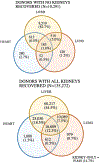Kidney nonprocurement in solid organ donors in the United States
- PMID: 32342627
- PMCID: PMC8448558
- DOI: 10.1111/ajt.15952
Kidney nonprocurement in solid organ donors in the United States
Abstract
There are limited data on the nonprocurement of kidneys from solid organ donors. Analysis of Standard Transplant Analysis and Research files was undertaken on all deceased donors in the United States with at least 1 solid organ recovered. From 2000 to 2018, 21 731 deceased donor kidneys (averaging 1144 kidneys per year) were not procured. No kidneys were procured from 8% of liver donors, 3% of heart donors, and 3% of lung donors. Compared to donors with all kidneys procured, those with none procured were older and more likely obese, black, hypertensive, diabetic, hepatitis C positive, smokers, Public Health Service - Increased Risk designated, deceased after cardiac death, or deceased after cerebrovascular accident. Although these donors had lower quality kidneys (median Kidney Donor Risk Index (interquartile range) 1.9 (1.0) vs 1.2 (0.7)), there was substantial overlap in quality between nonprocured and procured kidneys. Nearly one third of nonprocurements were attributed to donor history. Donors with elevated terminal creatinine likely resulting from acute kidney injury (AKI) had higher odds of kidney nonprocurement. Nonprocurement odds varied widely across Organ Procurement and Transplantation Network regions, with a positive correlation between donor kidney nonprocurements and kidney discards at the donation service area level. These findings suggest current discard rates underestimate the underutilization of deceased donor kidneys and more research is needed to optimize safe procurement and utilization of kidneys from donors with AKI.
Keywords: United Network for Organ Sharing (UNOS); clinical research/practice; donors and donation: deceased; health services and outcomes research; kidney transplantation/nephrology; organ acceptance; organ procurement; organ procurement and allocation; organ procurement organization.
© 2020 The American Society of Transplantation and the American Society of Transplant Surgeons.
Conflict of interest statement
DISCLOSURE
The authors of this manuscript have conflicts of interests to disclose as described by the
Figures





References
-
- Tonelli M, Wiebe N, Knoll G, et al.Systematic review: kidney transplantation compared with dialysis in clinically relevant outcomes. Am J Transplant. 2011;11(10):2093–2109. - PubMed
-
- Wolfe RA, Ashby VB, Milford EL, et al.Comparison of mortality in all patients on dialysis, patients on dialysis awaiting transplantation, and recipients of a first cadaveric transplant. N Engl J Med. 1999;341(23):1725–1730. - PubMed
-
- United States Executive Office of the President [Donald J. Trump]: Executive Order 13,879: Advancing American Kidney Health. Fed Regist. 2019;84:33817–33819.
-
- Israni AK, Zaun D, Rosendale JD, Schaffhausen C, Snyder JJ, Kasiske BL. OPTN/SRTR 2017 annual data report: deceased organ donation. Am J Transplant. 2019;19(S2):485–516. - PubMed
-
- Hart A, Smith JM, Skeans MA, et al.OPTN/SRTR 2017 annual data report: kidney. Am J Transplant. 2019;19(S2):19–123. - PubMed
Publication types
MeSH terms
Grants and funding
LinkOut - more resources
Full Text Sources
Medical

